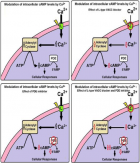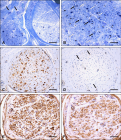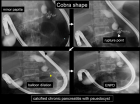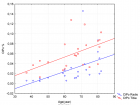Abstract
Research Article
Biodegradation of waste streams containing benzene, toluene, ethylbenzene and xylene (BTEX): Practical implications and brief perspectives
Srishti Singh*
Published: 12 June, 2019 | Volume 3 - Issue 1 | Pages: 007-010
Benzene (B), toluene (T), ethylbenzene (E) and xylene (X), collectively named as BTEX are mono-aromatic ring compounds with a 6-carbon benzene ring. Due to the presence of the aromatic ring, these compounds, especially benzene, are generally considered to be non-reactive species [1].
Read Full Article HTML DOI: 10.29328/journal.aac.1001018 Cite this Article Read Full Article PDF
References
- Bunnett JF, Draper F Jr, Ryason PR, Noble P Jr, Tonkyn RG, et al. Comparative activation of nucleophilic substitution in 4-substituted-2-nitrochlorobenzenes. J Am Chem Soc. 1953; 75: 642-645. Ref.: http://bit.ly/2R5LbvY
- Anderson MA. Removal of MTBE and other organic contaminants from water by sorption to high silica zeolites. Environ Sci Technol. 2000; 34: 725-727. Ref.: http://bit.ly/2WzA6cI
- Su F, Lu C, Johnston KR, Hu S. Kinetics, thermodynamics, and regeneration of BTEX adsorption in aqueous solutions via NaOCl-oxidized carbon nanotubes. Environanotechnology. 2010; 71-97. Ref.: http://bit.ly/2Zk9HfW
- Borden RC, Daniel RA, LeBrun LE, Davis CW. Intrinsic biodegradation of MTBE and BTEX in a gasoline‐contaminated aquifer. Water Resources Research. 1997; 33: 1105-1115. Ref.: http://bit.ly/2Wxogj4
- Cozzarelli IM, Bekins BA, Baedecker MJ, Aiken GR, Eganhouse RP, et al. Progression of natural attenuation processes at a crude-oil spill site: I. Geochemical evolution of the plume. J Contam Hydrol. 2001; 53: 369-385. Ref.: http://bit.ly/2KHCTte
- Dutta C, Som D, Chatterjee A, Mukherjee AK, Jana TK, et al. Mixing ratios of carbonyls and BTEX in ambient air of Kolkata, India and their associated health risk. Environ Monit Assess. 2009; 148: 97-107. Ref.: http://bit.ly/2X3guwP
- Mitra S, Roy P. BTEX: A serious ground-water contaminant. Res J Environ Sci. 2011; 5: 394-398. Ref.: http://bit.ly/2wMQDdP
- El-Naas MH, Acio JA, El Telib AE. Aerobic biodegradation of BTEX: progresses and prospects. J Environ Che Eng. 2014; 2: 1104-1122. Ref.: http://bit.ly/2XFSg98
- Bekins BA, Cozzarelli IM, Godsy EM, Warren E, Essaid HI, et al. Progression of natural attenuation processes at a crude oil spill site: II. Controls on spatial distribution of microbial populations. J Contam Hydrol. 2001; 53: 387-406. Ref.: http://bit.ly/2MCvmhK
- Yadav JS, Reddy CA. Degradation of benzene, toluene, ethylbenzene, and xylenes (BTEX) by the lignin-degrading basidiomycete Phanerochaete chrysosporium. Appl Environ Microbiol. 1993; 59: 756-762. Ref.: http://bit.ly/2KIP2y2
- Jo MS, Rene ER, Kim SH, Park HS. An analysis of synergistic and antagonistic behavior during BTEX removal in batch system using response surface methodology. J Hazard Mater. 2008; 152: 1276-1284. Ref.: http://bit.ly/2WylwSC
- Peterson CH, Rice SD, Short JW, Esler D, Bodkin JL, et al. Long-term ecosystem response to the Exxon Valdez oil spill. Science. 2003; 302: 2082-2086. Ref.: http://bit.ly/2I8FzOz
- Atlas RM. Petroleum biodegradation and oil spill bioremediation. Marine Pollution Bulletin. 1995; 31: 178-182. Ref.: http://bit.ly/2X2oIFy
- Díaz MP, Boyd KG, Grigson SJ, Burgess JG. Biodegradation of crude oil across a wide range of salinities by an extremely halotolerant bacterial consortium MPD‐M, immobilized onto polypropylene fibers. Biotechnol Bioeng. 2002; 79: 145-153. Ref.: http://bit.ly/2MFdAub
- Shen YF, Tang J, Nie ZH, Wang YD, Ren Y, et al. Preparation and application of magnetic Fe3O4 nanoparticles for wastewater purification. Separation and Purification Technology. 2009; 68: 312-319. Ref.: http://bit.ly/2XGPWyK
- Nakano Y, Takeshita K, Tsutsumi T. Adsorption mechanism of hexavalent chromium by redox within condensed-tannin gel. Water Res. 2001; 35: 496-500. Ref.: http://bit.ly/2WvDLmG
- Bacelo HA, Santos SC, Botelho CM. Tannin-based biosorbents for environmental applications - a review. Chem Eng J. 2016; 303: 575-587. Ref.: http://bit.ly/2MFe03J
- El Sissi HI, Saleh NAM, El Sherbeiny AEA, El Ansary MAI. Local plants as potential sources of tannins and the isolation of their free and combined sugars. Qualitas Plantarum et Materiae Vegetabiles. 1965; 12: 262-268. Ref.: http://bit.ly/2Iz3lm5
- Harms H, Schlosser D, Wick LY. Untapped potential: exploiting fungi in bioremediation of hazardous chemicals. Nat Rev Microbiol. 2011; 9: 177-192. Ref.: http://bit.ly/2Ixxsdv
- Pan B, Xing B. Adsorption mechanisms of organic chemicals on carbon nanotubes. Environ Sci Technol. 2008; 42: 9005-9013. Ref.: http://bit.ly/2MEZg4Q
- Mareddy AR, Shah A, Davergave N. Environmental impact assessment: theory and practice, Butterworth-Heinemann, Oxford, United Kingdom. 2017; Ref.: http://bit.ly/2I7VmNN
Similar Articles
-
Neutralizing scFv Antibodies against Infectious Bursal Disease Virus Isolated From a Nlpa-Based Bacterial Display LibraryTianhe Li*,Bing Zhou*,Tingqiao Yu,Ning Li,Xiaochen Guo,Tianyuan Zhang,Jingzhuang Zhao,Liming Xu,Siming Li,Lei Ma,Tingting Li,Liangjun Ding,Mingzhe Sun,Deshan Li,Jiechao Yin. Neutralizing scFv Antibodies against Infectious Bursal Disease Virus Isolated From a Nlpa-Based Bacterial Display Library. . 2017 doi: 10.29328/journal.aac.1001001; 1: 001-011
-
Photocatalytic Degradation of Microcystins-LR over Mesoporous graphitic Carbon Nitride (mpg-CN)Laiyan Wu*,Jirong Lan,Anping Yang,Yanxi Zhao,Songbo Wang,Junjiang Zhu*. Photocatalytic Degradation of Microcystins-LR over Mesoporous graphitic Carbon Nitride (mpg-CN). . 2017 doi: 10.29328/journal.aac.1001002; 1: 012-22
-
The impact of geographical origin on specific properties of pine honeyIoannis K Karabagias*,Christos Nikolaou,Ilias Gatzias. The impact of geographical origin on specific properties of pine honey. . 2017 doi: 10.29328/journal.aac.1001003; 1: 023-031
-
Convenient route synthesis of some new benzothiazole derivatives and their pharmacological screening as antimicrobial agentsAhmed A Fadda*,Nanees N Soliman,Ahmed Fekri. Convenient route synthesis of some new benzothiazole derivatives and their pharmacological screening as antimicrobial agents. . 2017 doi: 10.29328/journal.aac.1001004; 1: 032-046
-
How Bruguiera gymnorhizza seedlings respond to climate change induced salinity rise?Prosenjit Pramanick,Subrata Trivedi,Sufia Zaman,Abhijit Mitra*. How Bruguiera gymnorhizza seedlings respond to climate change induced salinity rise?. . 2017 doi: 10.29328/journal.aac.1001005; 1: 047-052
-
Synthesis of some new Schiff bases of Pharmaceutical InterestAjay Kumar,Shweta Verma,Arun K Mishra,Sushil Kumar*. Synthesis of some new Schiff bases of Pharmaceutical Interest. . 2017 doi: 10.29328/journal.aac.1001006; 1: 053-056
-
Retrosynthesis analysis; a way to design a retrosynthesis map for Pyridine and pyrimidine ringSamar S Fatahala*. Retrosynthesis analysis; a way to design a retrosynthesis map for Pyridine and pyrimidine ring. . 2017 doi: 10.29328/journal.aac.1001007; 1: 057-060
-
Combinatorial Therapeutic Approaches to DNA/RNA and Benzylpenicillin (Penicillin G), Fluoxetine Hydrochloride (Prozac and Sarafem), Propofol (Diprivan), Acetylsalicylic Acid (ASA) (Aspirin), Naproxen Sodium (Aleve and Naprosyn) and Dextromethamphetamine Nanocapsules with Surface Conjugated DNA/RNA to Targeted Nano Drugs for Enhanced Anti-Cancer Efficacy and Targeted Cancer Therapy Using Nano Drugs Delivery SystemsAlireza Heidari*,Christopher Brown. Combinatorial Therapeutic Approaches to DNA/RNA and Benzylpenicillin (Penicillin G), Fluoxetine Hydrochloride (Prozac and Sarafem), Propofol (Diprivan), Acetylsalicylic Acid (ASA) (Aspirin), Naproxen Sodium (Aleve and Naprosyn) and Dextromethamphetamine Nanocapsules with Surface Conjugated DNA/RNA to Targeted Nano Drugs for Enhanced Anti-Cancer Efficacy and Targeted Cancer Therapy Using Nano Drugs Delivery Systems. . 2017 doi: 10.29328/journal.aac.1001008; 1: 061-069
-
Impact of alloimmunization on transfusion-dependent patientsSurapon Tangvarasittichai*. Impact of alloimmunization on transfusion-dependent patients. . 2017 doi: 10.29328/journal.aac.1001009; 1: 070-082
-
The Role of Tau Protein in DiseasesBhaskar C Das*,Sribidya Pradhan,Devi Prasana Ojha,Arpita Das,Narayan S Hosmane,Sasmita Das. The Role of Tau Protein in Diseases. . 2018 doi: 10.29328/journal.aac.1001010; 2: 001-016
Recently Viewed
-
Feature Processing Methods: Recent Advances and Future TrendsShiying Bai,Lufeng Bai*. Feature Processing Methods: Recent Advances and Future Trends. J Clin Med Exp Images. 2025: doi: 10.29328/journal.jcmei.1001035; 9: 010-014
-
Severe hypertriglycerdemia in pregnancyKrithika Muralidhara*,Shashank Dhareshwar. Severe hypertriglycerdemia in pregnancy. Clin J Obstet Gynecol. 2021: doi: 10.29328/journal.cjog.1001080; 4: 019-019
-
PTM-Fetuin-A: A Novel Biomarker for Early Detection of Diabetic Kidney DiseaseBenkova M,Petrov P,Aleksandar Petrov*,Staykova S,Zlatanova E,Chervenkov T,Nikolova S. PTM-Fetuin-A: A Novel Biomarker for Early Detection of Diabetic Kidney Disease. J Clini Nephrol. 2025: doi: 10.29328/journal.jcn.1001146; 9: 013-019
-
Intelligent Design of Ecological Furniture in Risk Areas based on Artificial SimulationTorres del Salto Rommy Adelfa*, Bryan Alfonso Colorado Pástor*. Intelligent Design of Ecological Furniture in Risk Areas based on Artificial Simulation. Arch Surg Clin Res. 2024: doi: 10.29328/journal.ascr.1001083; 8: 062-068
-
A rare case of giant ovarian serous cystadenoma presenting as psuedo-meigs syndromeRichmond Ronald Gomes*,Sayeda Noureen,Habiba Akhter. A rare case of giant ovarian serous cystadenoma presenting as psuedo-meigs syndrome. Clin J Obstet Gynecol. 2021: doi: 10.29328/journal.cjog.1001078; 4: 010-014
Most Viewed
-
Evaluation of Biostimulants Based on Recovered Protein Hydrolysates from Animal By-products as Plant Growth EnhancersH Pérez-Aguilar*, M Lacruz-Asaro, F Arán-Ais. Evaluation of Biostimulants Based on Recovered Protein Hydrolysates from Animal By-products as Plant Growth Enhancers. J Plant Sci Phytopathol. 2023 doi: 10.29328/journal.jpsp.1001104; 7: 042-047
-
Sinonasal Myxoma Extending into the Orbit in a 4-Year Old: A Case PresentationJulian A Purrinos*, Ramzi Younis. Sinonasal Myxoma Extending into the Orbit in a 4-Year Old: A Case Presentation. Arch Case Rep. 2024 doi: 10.29328/journal.acr.1001099; 8: 075-077
-
Feasibility study of magnetic sensing for detecting single-neuron action potentialsDenis Tonini,Kai Wu,Renata Saha,Jian-Ping Wang*. Feasibility study of magnetic sensing for detecting single-neuron action potentials. Ann Biomed Sci Eng. 2022 doi: 10.29328/journal.abse.1001018; 6: 019-029
-
Pediatric Dysgerminoma: Unveiling a Rare Ovarian TumorFaten Limaiem*, Khalil Saffar, Ahmed Halouani. Pediatric Dysgerminoma: Unveiling a Rare Ovarian Tumor. Arch Case Rep. 2024 doi: 10.29328/journal.acr.1001087; 8: 010-013
-
Physical activity can change the physiological and psychological circumstances during COVID-19 pandemic: A narrative reviewKhashayar Maroufi*. Physical activity can change the physiological and psychological circumstances during COVID-19 pandemic: A narrative review. J Sports Med Ther. 2021 doi: 10.29328/journal.jsmt.1001051; 6: 001-007

HSPI: We're glad you're here. Please click "create a new Query" if you are a new visitor to our website and need further information from us.
If you are already a member of our network and need to keep track of any developments regarding a question you have already submitted, click "take me to my Query."


















































































































































